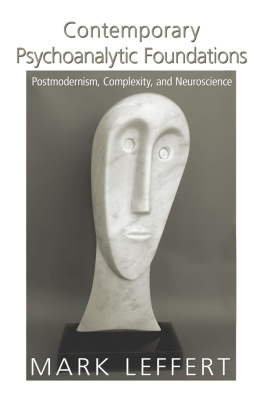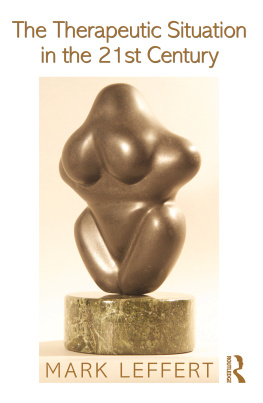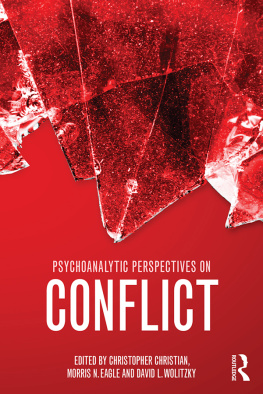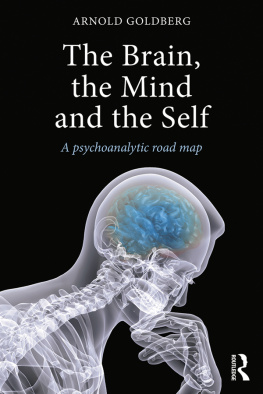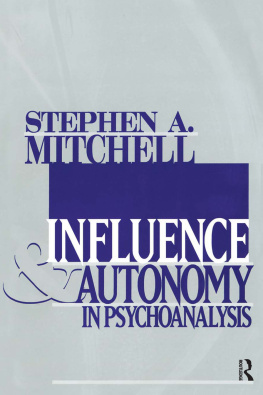Contemporary
Psychoanalytic
Foundations
Postmodernism, Complexity, and Neuroscience
MARK LEFFERT

| Routledge | Routledge |
| Taylor & Francis Group | Taylor & Francis Group |
| 270 Madison Avenue | 27 Church Road |
| New York, NY 10016 | Hove, East Sussex BN3 2FA |
2010 by Taylor and Francis Group, LLC
Routledge is an imprint of Taylor & Francis Group, an Informa business
Printed in the United States of America on acid-free paper
10 9 8 7 6 5 4 3 2 1
International Standard Book Number: 978-0-88163-496-9 (Hardback) 978-0-88163-497-6 (Paperback)
For permission to photocopy or use material electronically from this work, please access www.copyright.com (http://www.copyright.com/) or contact the Copyright Clearance Center, Inc. (CCC), 222 Rosewood Drive, Danvers, MA 01923, 978-750-8400. CCC is a not-for-profit organization that provides licenses and registration for a variety of users. For organizations that have been granted a photocopy license by the CCC, a separate system of payment has been arranged.
Trademark Notice: Product or corporate names may be trademarks or registered trademarks, and are used only for identification and explanation without intent to infringe.
Library of Congress Cataloging-in-Publication Data
Leffert, Mark.
Contemporary psychoanalytic foundations : postmodernism, complexity, and neuroscience / Mark Leffert.
p. cm.
Includes bibliographical references and index.
ISBN 978-0-88163-496-9 (hbk.) -- ISBN 978-0-88163-497-6 (pbk.) -- ISBN
978-0-203-88824-7 (e-book)
1. Psychoanalysis. 2. Postmodernism. I. Title.
BF175.L44 2010
150.195--dc22 2009034291
Visit the Taylor & Francis Web site at
http://www.taylorandfrancis.com
and the Routledge Web site at
http://www.routledgementalhealth.com
Contents
Since I saw my first psychotherapy patient in 1968, the world in which psychoanalysis lives has changed so much that it would be almost unrecognizable to a psychoanalyst from those times. This book describes these changes, their meaning, and how they came about. In many ways, they parallel my evolving experience as a therapist and psychoanalyst. A brief description of my development as a psychoanalyst seems a useful way to introduce this book. However, some of my experiences became relevant to my current work only much later and in retrospect.
I was educated to be an orthodox Freudian in my psychiatric residency during the early 1970s, at Albert Einstein College of Medicine, then among the most psychoanalytically oriented training programs in the United States. My psychoanalytic training took place at the San Diego Psychoanalytic Institute in the late 1970s. It was at that time a new facility whose faculty had come from many institutes of differing ilks. The care that they took with every facet of our analytic education was unlike anything I have seen elsewhere since, and I have been closely involved with four other institutes. My teachers are almost all gone now, and I miss them. In keeping with the times, they taught not-so-orthodox Freudian psychoanalysis to which they added modest doses of self psychology, object relations theory, and the British Middle School. I was also educated in the traditions of the radical critics of classical ego psychology of the 1960s and 1970s; George Klein, Charles Fisher, Merton Gill, and Pinchus Noy were prominent among them.
My clinical work in the 1970s and 1980s was, given my background, much as you might imagine except for a few telltale quirks. I tried hard to maintain clinical neutrality but, fortunately, was only marginally successful at it; I achieved some of the letter of it but little of the spirit. I also retained an aspect of technique from my earliest, still nave, clinical experience in which I asked questions, lots of questions (a technique still frowned on in some analytic circles). I noticed gaps or inconsistencies in the stories patients told me about themselves, and I regularly inquired about them. The questions always seemed to get us someplace. Much later, I would learn that such stories are postmodern narratives, and the technique I was using was deconstruction. I was drawn also to Merton Gills (1982) linked observations that psychoanalysis, as it was practiced, was generally not of good quality, and this failure grew out of an inability or an unwillingness to analyze the here-and-now aspects of the transference.
Shortly after completing my analytic training in 1981, I moved away from San Diego because of the scarcity of analytic cases; I went to Minneapolis, where there was a scarcity of psychoanalysts. My experience during the 1990s was unremarkable and much like that of any progressive psychoanalyst; I became interested in enactments, two-person psychologies, and the relational and intersubjectivist schools. No religious conversions took place. I did come on Irwin Hoffmans (1998) work, which I considered of great importance. It led me to the beginnings of postmodernism, a subject that I have since pursued.
In 1999, I moved halfway across the country to Santa Barbara. For a number of reasons, I continued to work via telephone with most of my patients, an unusual decision for the times (Leffert, 2003). During the next few years, I read and taught about postmodernism and its relevance to psychoanalysis. I made a jump from reading analytic authors who were influenced by postmodernism to reading the postmodern literature itself. A chance encounter with a colleague who is a sociologist led me to Bruno Latours We Have Never Been Modern (1991/1993), which has influenced my work and which you will read about in the following pages. Two published articles (Leffert, 2007a, 2007b) grew out of my review of these works; they appear, in expanded form, as theories I was developing as heresy. I would posit that his classification was not based at all on knowledge claims but rather on the dynamics of power relations.
I have continued to question the kinds of knowledge claims that can be made about the events of a particular psychoanalysis and their meanings . One might ask what complexity theory has to do with postmodernism. Although the answer is quite a lot, the question has validity and moved me beyond the original postmodern inquiry to cast a wider net, exploring how other disciplines might have an impact on psychoanalysis.
Sometime during these explorations, the idea of this becoming a book-length project began to take shape. As I thought about it, I hoped that a book would work like the holistic systems I was writing about, not just a collection of papers stuck together in one volume. As Edward Said (1994) suggested, discourse only appears to have a beginning; it actually has a chosen point of entry that in retrospect appears to be a beginning because that choice exerts so much influence on the argument that follows. In keeping with these considerations, I chose to begin this book with two chapters that would locate the reader in the series of arguments that I would make. For illustrative purposes, the chapters include clinical vignettes, but their focus is critical and theoretical. Chapters that followed were to have applied these ideas to a series of proposed revisions to clinical theory and technique. However, as sometimes happens, events overtook this plan. (The original itinerary will be the subject of a subsequent volume.)

